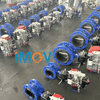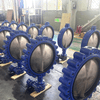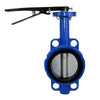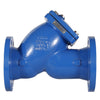Wafer vs Lug Butterfly Valve: How to Choose
In butterfly valve connections, wafer-type and lug-type designs are the two most commonly used configurations in engineering projects. Although they look similar at first glance, the way they are connected to the pipeline—and the installation requirements and applicable scenarios—are very different.
Understanding the fundamental differences between these two structures helps engineers, designers, and procurement teams make the right selection for their system.
This article breaks down the differences in structure, installation method, application scenarios, and maintenance, helping you quickly determine which design is better suited for your pipeline.
Wafer vs. Lug Butterfly Valves: Structural Connection Differences
Wafer-Type Butterfly Valve Connection
A wafer butterfly valve does not have its own flanges or individual bolt holes.
Instead, it is installed between two pipe flanges, and long bolts pass through both flanges to “clamp” the valve securely in place.
The sealing performance depends heavily on the compression provided by the two flanges.
Structural Characteristics
-
Shortest and most compact design
For the same nominal size, wafer-type butterfly valves typically have the shortest face-to-face dimension, making them ideal for tight installation spaces. -
Requires clamping from both sides
Because the valve body cannot withstand axial load from only one side, it must be supported and compressed simultaneously by both flanges. It cannot be used where one side of the pipeline is unsupported.
Maintenance Characteristics
- Removal affects the entire pipeline section
- The long bolts pass through both flanges, so removing a wafer valve requires disconnecting both sides of the piping.
- You cannot keep one side stationary during maintenance, which increases the impact range and workload.
Application Limitations
- Not suitable for end-of-line (EOL) service
- A wafer butterfly valve cannot rely on a single flange to hold pressure or maintain sealing.
- If installed at the end of a pipeline with only one flange connection, the valve body may shift under pressure, leading to leakage—or even being pushed out of the flange entirely.
For this reason, wafer butterfly valves must not be used as end-of-line isolation valves.

Lug-Type Butterfly Valve Connection
A lug-type butterfly valve has a body with threaded lugs cast around the rim. During installation, short bolts are inserted from the outside of each pipe flange and screwed directly into these threaded lugs.
Because the bolts fasten into the valve body itself, the valve can be securely fixed to one flange at a time—it does not rely on the opposite flange for support.
Structural Characteristics
-
Slightly Longer and More Robust Construction
Due to the cast lugs, the valve body is thicker and inherently stronger. Its face-to-face length is typically a bit longer than a wafer-type valve of the same size. -
Engineered to Withstand Single-Sided Load
The threaded lugs allow the valve body to handle axial pipe loads and flange forces from one side. This gives lug-type valves greater mechanical stability and makes them suitable for more demanding installation conditions.
Maintenance Characteristics
Easier Single-Side Removal
- To remove the valve, you only need to loosen the short bolts on one side.
- The opposite side of the pipeline can remain completely untouched, allowing maintenance work without shutting down the entire system or disassembling large pipe sections.
Application Advantages
Suitable for End-of-Line (EOL) or Sectional Isolation
- A lug-type butterfly valve can stay securely mounted even when connected to only one flange, effectively functioning as a blind flange.
- This is one of its greatest engineering advantages—it can be used at pipeline ends, for temporary shutdowns, or for isolating sections of a system during maintenance.

Key Factors When Choosing Between Wafer and Lug Butterfly Valves
1. End-of-Line Capability
This is often the first and most important factor in selecting between the two designs.
A wafer butterfly valve cannot be used at the end of a pipeline. Because it depends entirely on two flanges clamping it from both sides, it cannot withstand pressure or remain securely in place when only one flange is connected.
A lug-type butterfly valve, on the other hand, can be fully supported by bolts on one side. This allows it to function as an end-of-line (EOL) valve, effectively acting like a blind flange to close off the pipeline. This is one of its most valuable engineering advantages.
2. Maintenance Convenience
Wafer Type:
For inspection or replacement, the long bolts running across the entire assembly must be removed. This requires disconnecting both sides of the piping, increasing labor, downtime, and overall system disruption.
Lug Type:
Only the short bolts on one side need to be removed to take the valve out.
The downstream side remains completely untouched, allowing maintenance with minimal system interruption.
This makes lug valves ideal for pump connections, filters, and equipment that requires frequent cleaning or service.
3. Strength and Pressure Rating
Because lug-type butterfly valves incorporate cast threaded lugs, their bodies are generally stronger and more rigid.
They can typically withstand higher pipe stresses and pressure loads compared to wafer valves of the same size.
For applications where structural integrity, pipeline loading, or higher pressure ratings are critical, the lug-style design is the more reliable choice.
4. Space and Cost Factors
Wafer Type:
Offers advantages in compactness—shorter face-to-face length and lower weight.
The valve itself is usually less expensive, making it ideal for budget-sensitive projects or tight installation spaces.
Lug Type:
Although the valve cost is slightly higher, installation is faster and uses shorter, fewer bolts.
Over the long term, reduced downtime and easier maintenance often offset the higher initial purchase cost.
Application Summary
Typical Uses for Wafer Butterfly Valves
- Tight installation spaces
- Mid-line sections of pipelines
- Budget-sensitive projects
- Large-diameter, low-pressure water systems (HVAC chilled water, building water distribution, etc.)
Typical Uses for Lug Butterfly Valves
- Pump suction and discharge
- Equipment requiring isolation for maintenance
- Fire protection systems
- End-of-line service
- Chemical and process pipelines with higher mechanical demands

Frequently Asked Questions
Q1: Can a lug-type butterfly valve replace a wafer-type valve?
A:For most mid-line installations, yes—a lug valve can typically replace a wafer valve, provided there is enough space and the slightly higher cost is acceptable.
However, the reverse is not true:
If the design requires a lug-type installation (such as end-of-line service), a wafer valve must never be used as a substitute.
Q2: Besides wafer and lug types, what other connection style is available?
A:The third major type is the flanged butterfly valve.
Its body includes fully integrated flanges that bolt directly to the pipe flanges.
Among the three connection styles, flanged valves are the most robust, offer the highest pressure capability, and handle demanding conditions such as high pressure, high temperature, or corrosive media.
However, they are also the largest and most expensive option.
Q3: How should I choose the body material and seat material?
A:Material selection depends on the medium and operating conditions:
Valve body:
- Cast iron: general water applications
- Carbon steel: higher pressure or temperature
- Stainless steel: corrosive or sanitary applications
Seat materials:
- EPDM – water, HVAC, general services
- NBR – oils, hydrocarbons
- PTFE – high temperature, chemicals, corrosive media
Ensuring compatibility between the medium and the seat material is essential for long-term sealing performance.
Final Notes
Wafer and lug butterfly valves each offer distinct advantages and are designed for different installation needs. Selecting the right connection type based on system layout, maintenance requirements, and pressure conditions will ensure stable operation and easier upkeep.
If you need guidance for your specific application, feel free to contact Union Valve. Our engineering team can help you choose the most suitable butterfly valve solution for your project.









